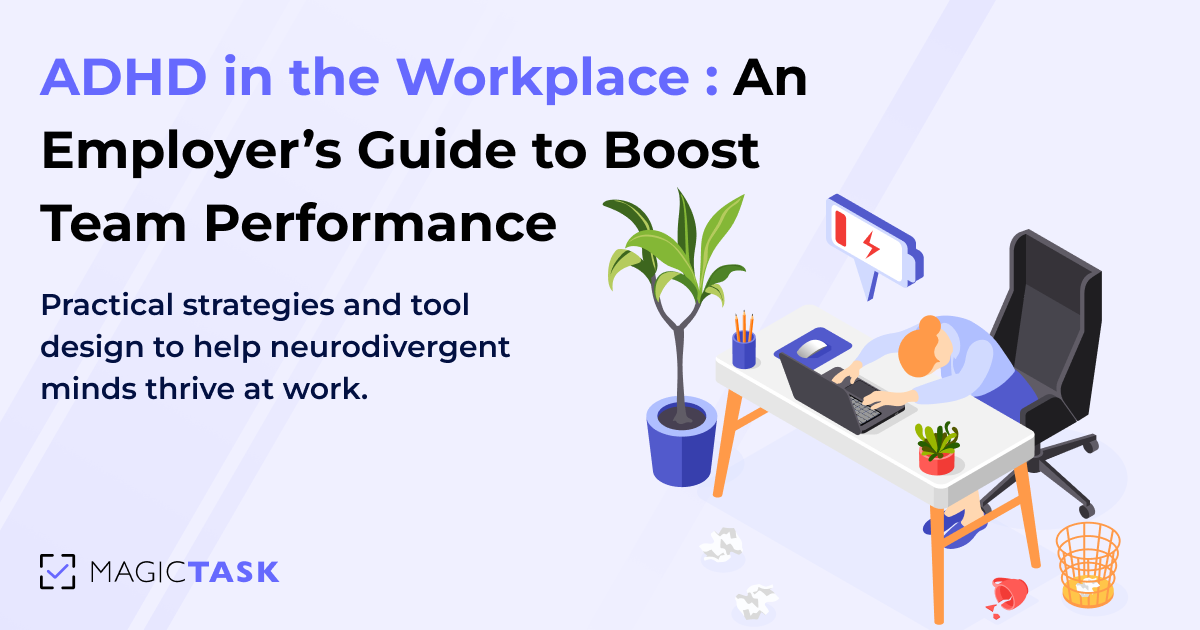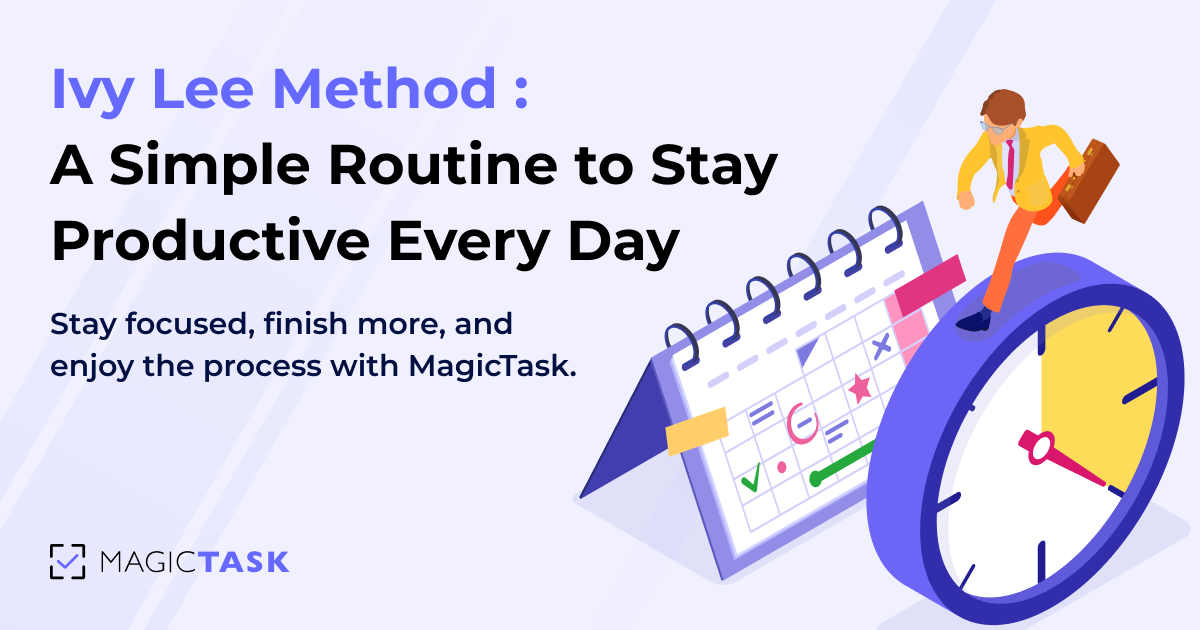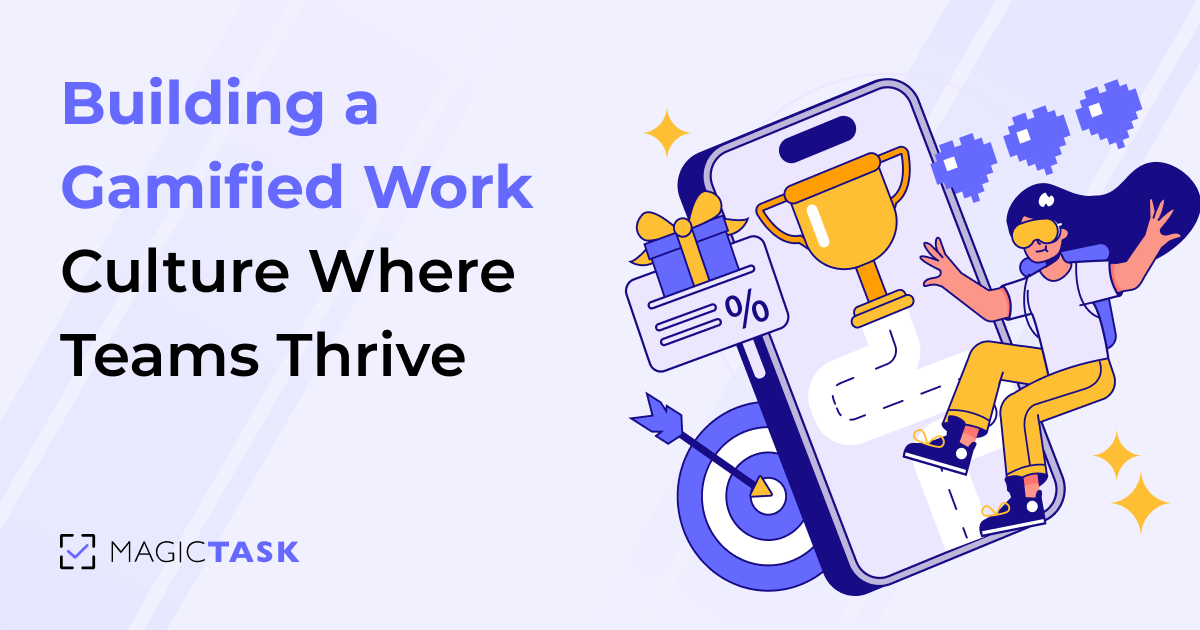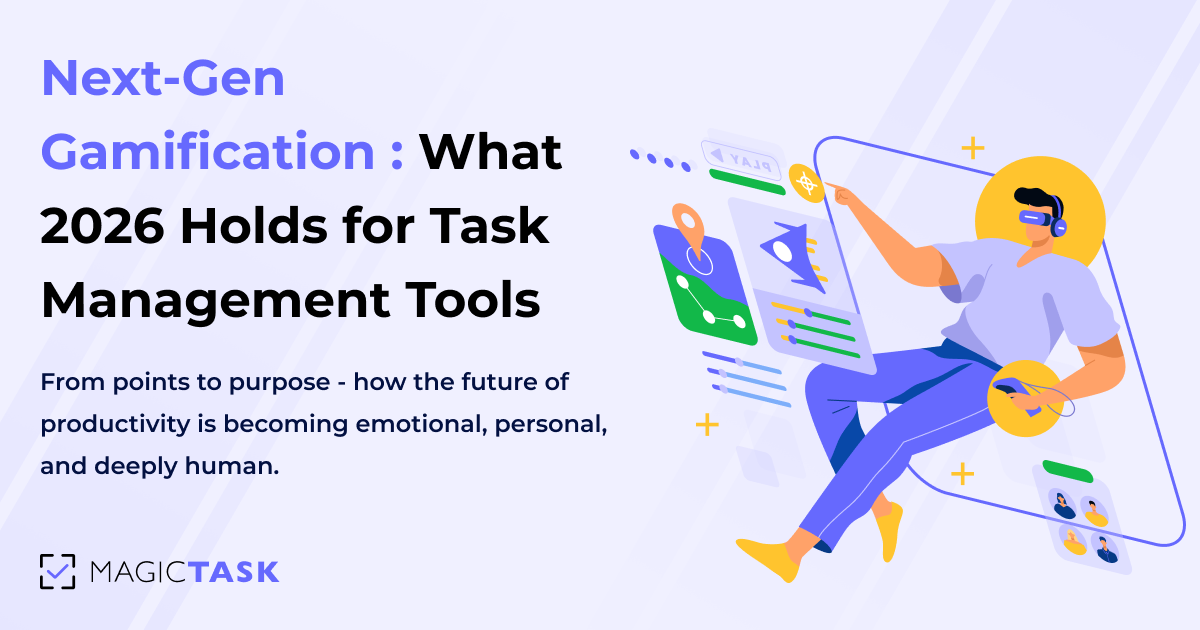Multitasking Kills Productivity – Here’s How to Work Smarter
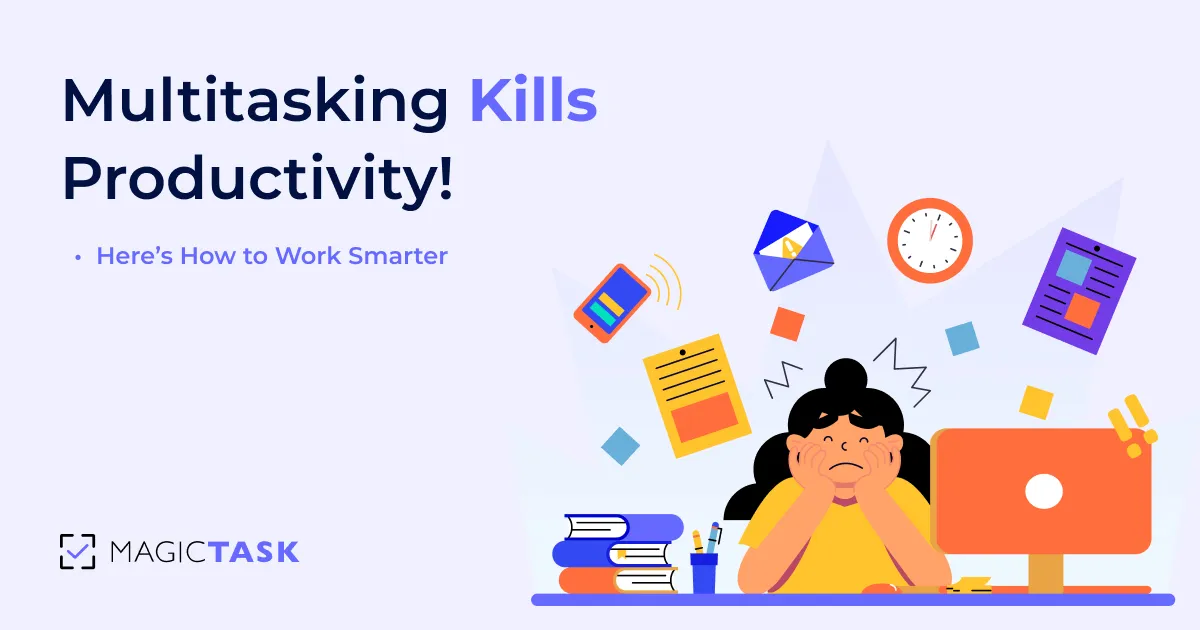
Many people believe that handling multiple tasks at once makes them more productive. Maybe you do, too.
Do you ever find yourself constantly hopping between emails, meetings, and tasks, yet nothing seems to get done? It turns out that the very act of multitasking—switching from one task to another—can slash your productivity by up to 40%.
So, what’s the best way to break free from the cycle of procrastination and finally get things done?
Instead of falling into the multitasking trap, let’s explore how to work efficiently without falling into the multitasking trap.
Why Multitasking Is Hurting Your Productivity
Before we get to smarter strategies, let’s pull back the curtain on the hidden toll multitasking takes.
1. Task-Switching Slows You Down
When you multitask, you usually switch between different tasks without taking a break.
It might seem harmless, but even a split-second distraction can cost you dearly when it comes to complex tasks.
Let’s say you have to complete a detailed financial report at the end of the day, along with a few other tasks.
Now, every time you switch gears to look at an email or a pop-up notification, you risk overlooking a critical piece of data. That fleeting half-second loss might seem trivial, yet over the course of the day, it can add up to costly mistakes and missed deadlines.
You need to understand that your brain takes time to reorient itself every time you switch tasks, creating mental lag.
In fact, a study discovered that after an interruption, it takes an average of 23 minutes and 15 seconds to regain focus on a task. By focusing on one task at a time, you cut out that extra lag and boost your overall efficiency.

But there's more at stake than just speed. The illusion of being busy comes at a greater cost.
2. More Mistakes, Less Focus
Your divided attention means you're more likely to overlook details and make mistakes. Multitasking hijacks your brain power.
According to research, multitasking can lower IQ by 15 points—the cognitive equivalent of pulling an all-nighter.
So, instead of having a clear, laser-sharp focus, your mind is spread too thin, and errors start to creep in.
This not only forces you to backtrack and rework what you've done, but it also drains your energy and hampers progress.
Even if you sidestep mistakes by narrowing your focus, the toll of constant task-switching doesn't stop there.

3. Increased Mental Fatigue
Imagine spending your morning drafting a report, only to be interrupted by a flood of emails and an unexpected phone call that forces you to jump to a different project.
Each time your brain has to hit the “reset” button, it drains your energy—like a phone battery that never quite reaches full charge.
And it’s not just your focus that takes a hit.
Multitasking has been found to spike cortisol levels, flooding your system with stress hormones that leave you mentally drained and inching closer to burnout.
By the end of the day, despite checking off countless tasks, you're left exhausted, unfocused, and wondering where your productivity went.
And what about the quality of work you managed to complete while multitasking? Is it good enough to make it to the top desk?

4. Surface-Level Work Instead of Deep Focus
When you're constantly bouncing between tasks, you're not diving deep—you’re just skimming the surface.
Instead of fully engaging with a project, your attention is fragmented, and the work looks rushed and incomplete.
You lack the depth and insight that come from focused effort.
And when there’s surface-level focus, you cannot always remember every detail of every task. Your brain barely has time to file away essential details.
5. Poor Memory Retention
Research shows that your brain loses some precious information whenever you switch tasks—it's like letting your best ideas slip through your fingers.
Constant switching erodes your memory, so when you need those key insights the most, they might be nowhere to be found in the back of your brain.
The logic is quite simple: when you focus on one task at a time, you reduce mistakes, boost your performance, and create work of a quality that stands out.
Deep focus leads to better, faster results that deserve a spot at the top of the desk.
As Gary Keller once said, “When you are trying to do two things at once, you either can’t or won’t do either well.”

So, how can you overcome these obstacles and work smarter without multitasking?
How to Work Smarter Instead of Multitasking
Let's explore practical strategies for harnessing laser-sharp focus and your full productivity potential.
1. Use Task Batching to Stay Focused
One of the most effective strategies is task batching. This means grouping similar tasks together and handling them in dedicated time blocks.
Consider this practical example:
Instead of interrupting your workflow by checking emails every few minutes, allocate a specific period solely for that purpose.
For example, you might decide to spend the first 30 minutes of your afternoon solely clearing your inbox rather than juggling emails throughout the day.
Then, group tasks like scheduling meetings, filing documents, or processing invoices into one continuous block later in the day.
Finally, dedicate uninterrupted time blocks for deep work—whether it’s brainstorming, drafting reports, or designing presentations—when you’re least likely to be disturbed.
The key is to prioritize your tasks according to their emergency and address them individually.
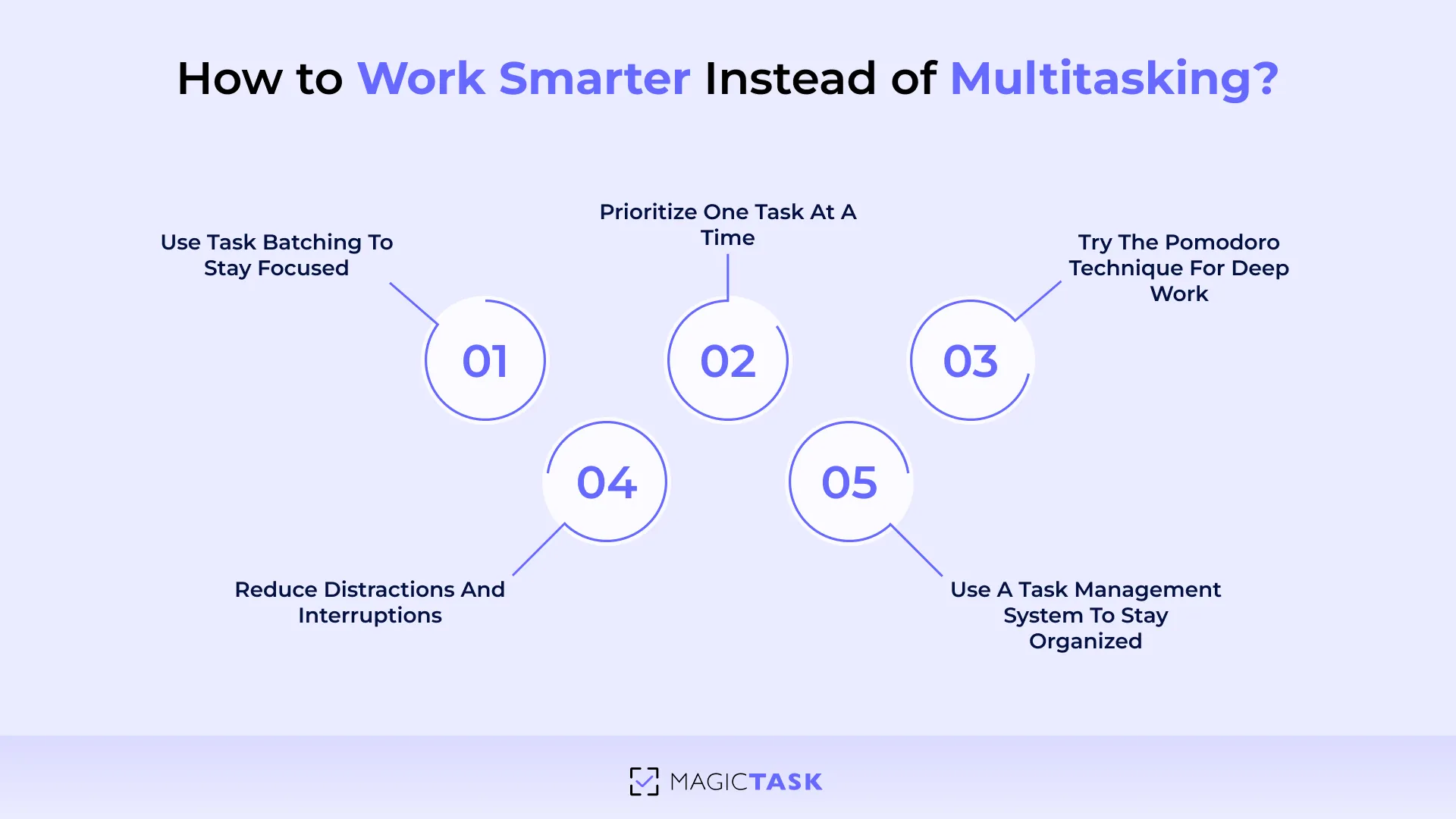
2. Prioritize One Task at a Time
Instead of jumping between tasks, complete one fully before moving on. A practical way to implement this is by using prioritization methods like the Eisenhower Matrix or the ABCD method.
The Eisenhower Matrix divides your tasks into four categories:
1. Urgent and Important: Tasks that demand immediate action.
Example: Responding to a client’s urgent request due in a few hours or fixing a critical bug in your software.
2. Important, Not Urgent: Tasks that contribute to your long-term goals but don’t require immediate attention.
Example: Planning a strategic initiative for the next quarter or working on professional development. These tasks are vital but can be scheduled for later so you can give them your undivided attention when the time is right.
3. Urgent, Not Important: Tasks that seem pressing but may not significantly impact your objectives.
Example: Handling routine administrative emails or scheduling minor meetings. They require action but can often be delegated or done quickly without deep focus.
4. Neither Urgent nor Important: These distractions can be minimized or eliminated.
Example: Browsing social media or checking non-essential notifications. Recognizing these helps you avoid wasting time on activities that don't add value.

By sorting tasks into these quadrants, you can quickly identify which items require immediate focus and effort and which can wait.
The ABCD method takes a slightly different approach by ranking tasks based on priority levels:
- A tasks: Must be done today—they’re your top priority.
- B tasks: Should be done soon, but are not as critical as A tasks.
- C tasks: Nice to do if time permits.
- D tasks: Delegate or drop these if they don’t contribute much to your goals.
This simple ranking system guides you to start with the most crucial tasks, ensuring that less important activities don’t dilute your attention.
If you’re clear on your task prioritization, you must dive deep into the task.
3. Try the Pomodoro Technique for Deep Work
The Pomodoro Technique is your kick to stay focused. This method breaks your day into focused 25-minute bursts of deep work—followed by a short break to catch your breath.
It’s like having a mini race against the clock, where each sprint propels you closer to your goals without letting distractions catch up.
It is your daily dose of productivity adrenaline. Instead of getting lost in endless hours of half-hearted effort, you commit to a solid focus block and recharge before diving back in.
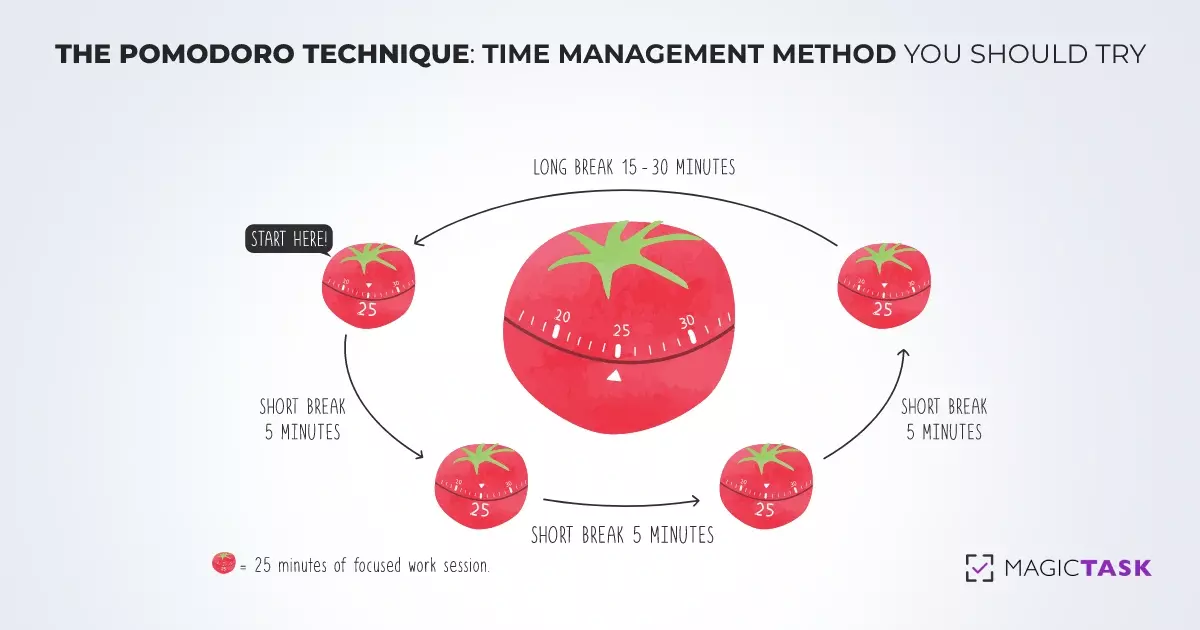
With each Pomodoro session, you're giving your mind a chance to refresh to keep your creative juices flowing. Embrace these short, intense bursts, and watch your work transform into achievable victories.
According to reports, using the Pomodoro Technique for repetitive tasks is very effective.
Once you've mastered those focused 25-minute sprints, the next challenge is keeping the chaos at bay.
4. Reduce Distractions and Interruptions
Every buzz and every ping is a thief, stealing your precious focus. Instead of letting your attention scatter with every interruption, set some ground rules. Tell your team, "I'm in the zone; please hold off until I'm done."
Turn off non-essential notifications and carve out a space where the clamor fades away. The real breakthrough comes when you create a quiet corner for your thoughts in a world that never stops talking.
That’s when you enter a flow state—where ideas flourish and work gets done. It’s about protecting your creative energy so you can make something truly remarkable.
All that’s left to do is bring order to the chaos.
5. Use a Task Management System to Stay Organized
When tasks pile up, it's easy to feel overwhelmed and slip into multitasking, which only deepens the clutter. Instead, a structured system gives you a clear plan.
Take a product launch, for example.
Instead of scribbling tasks on sticky notes and juggling them in your head, you break the project into clear, prioritized steps: market research, concept development, prototype creation, testing, and finally, launch.
A sound system lets you see these steps, track your progress, and hold you accountable without overloading your brain.
This way, you know exactly what needs to be done next and can celebrate each completed task.
How MagicTask Helps Eliminate Multitasking and Improve Productivity
Now that we've explored how cutting through distractions and focusing on one task at a time can transform your workday, it’s time to implement these strategies.
MagicTask helps you stay focused and improve your productivity. Here’s how:
1. Focus on One Task at a Time with a Gamified System
With MagicTask, you can clear the clutter from your mind by dumping all your tasks into one central "Backlog."
Once you add all your tasks, you assign each one a size—S, M, L, or XL—based on its complexity, deadline, or due date. This simple classification helps you understand the scope of each task at a glance.

When it’s time to work, you drag and drop the task that’s due today—or the one that really needs your attention—into your "My Focus" section. At that moment, you focus solely on that task.
All other tasks remain in the Backlog, out of sight and out of mind, until you're done. Only when you complete and check off the focused task do you return to the Backlog to pick your next priority.
This process creates a distraction-free environment where you can give your full attention to the task at hand. By isolating each task in the "My Focus" zone, MagicTask helps you make genuine progress and rewards you for a job well done.
2. Earn Points and Level Up for Task Completion
Every time you finish a task, you earn points. This system offers simple, measurable proof that you're making progress.
It reinforces the habit of focusing on one task at a time instead of bouncing between incomplete work. As your points accumulate, you level up and unlock new animations and themes that make your progress visible and engaging.
The beauty of this approach is its clarity. You know precisely what you’ve accomplished, and every completed task pushes you closer to a new level. It’s a tangible way to see progress and stay motivated, ensuring that every effort counts.
3. No More Clutter – A Clean and Intuitive Task Management Experience
While tracking your wins is crucial, keeping your workspace free of distractions is just as important.
If you have ever worked with Asana or Notion, you must have noticed that layers of features and endless data pages become overwhelming. Instead of helping with task management, these platforms draw your precious time into customization.
MagicTask takes a different approach. Its clean, intuitive design ensures that you see only what matters—your tasks and priorities—without the extra clutter.
This smooth experience reduces the urge to multitask and keeps your focus exactly where it should be. With MagicTask, every minute is dedicated to progress, not wrestling with confusing interfaces.
4. Stay Motivated with Progress Tracking and Leaderboards
With the clutter out of the way, MagicTask takes it further by celebrating every win. With its built-in progress tracking and leaderboards, you can see exactly how much you've accomplished and how close you are to your next milestone.
Instead of your progress disappearing into the background, it's displayed front and center—giving you an instant snapshot of how far you've come. This clarity turns every completed task into a motivational milestone that keeps you moving forward.
With leaderboards that track individual and team performance, MagicTask injects a healthy dose of competition into your day. Watching your name climb the ranks against colleagues or even on a global scale fuels that drive to excel, one focused task at a time.
Every point earned, every level up, and every badge unlocked is a reminder that your focused efforts are paying off. You don’t need to complete all things at once. Just the ones that count.
Conclusion: Work Smarter, Not Harder
It's clear that multitasking is a constant shuffle from one task to another—a pattern that slows you down, reduces quality, and drains energy.
The more thoughtful way forward is simple: zero in on one task at a time, prioritize what truly matters, and let your work speak for itself.
By eliminating the urge to switch between tasks, you'll find that you not only achieve faster, better results but also enjoy a calmer, more satisfying workday.
Are you ready to leave the chaos behind? It's time to ditch the myth of multitasking and embrace a focused, efficient way of working with MagicTask.
